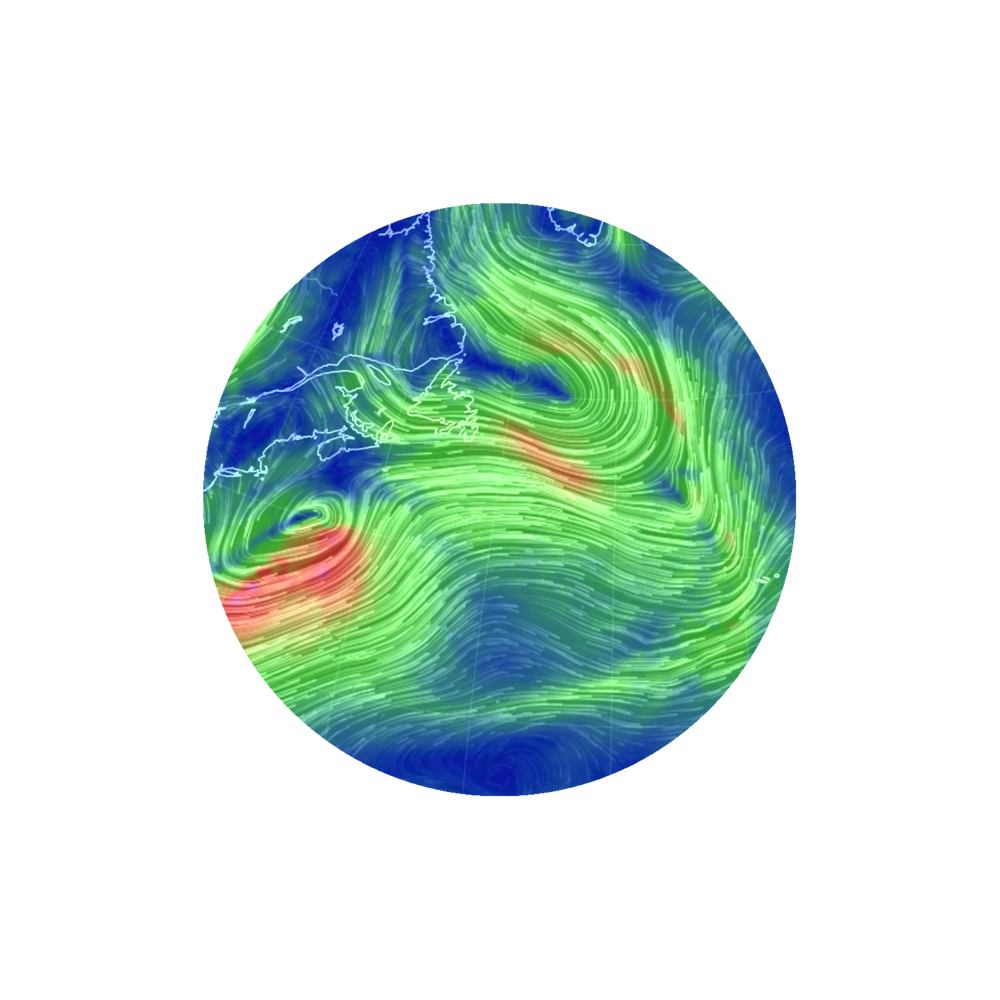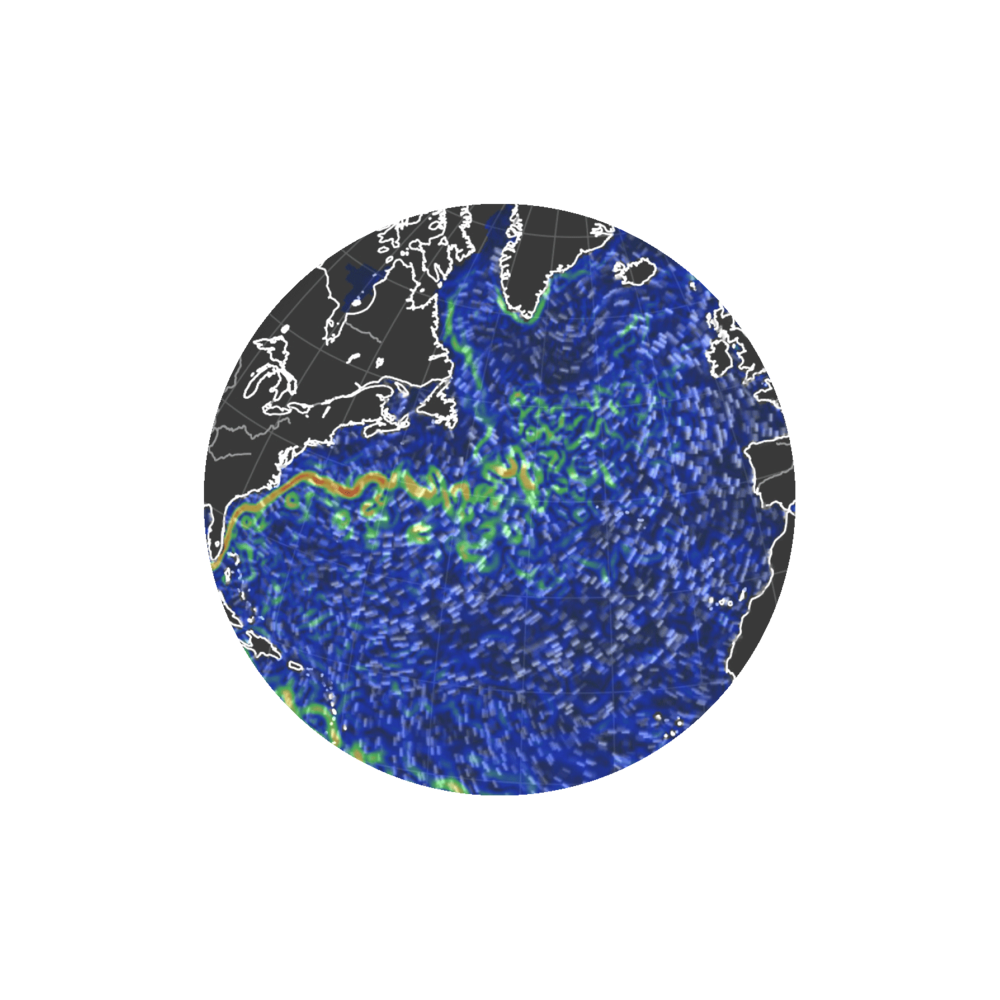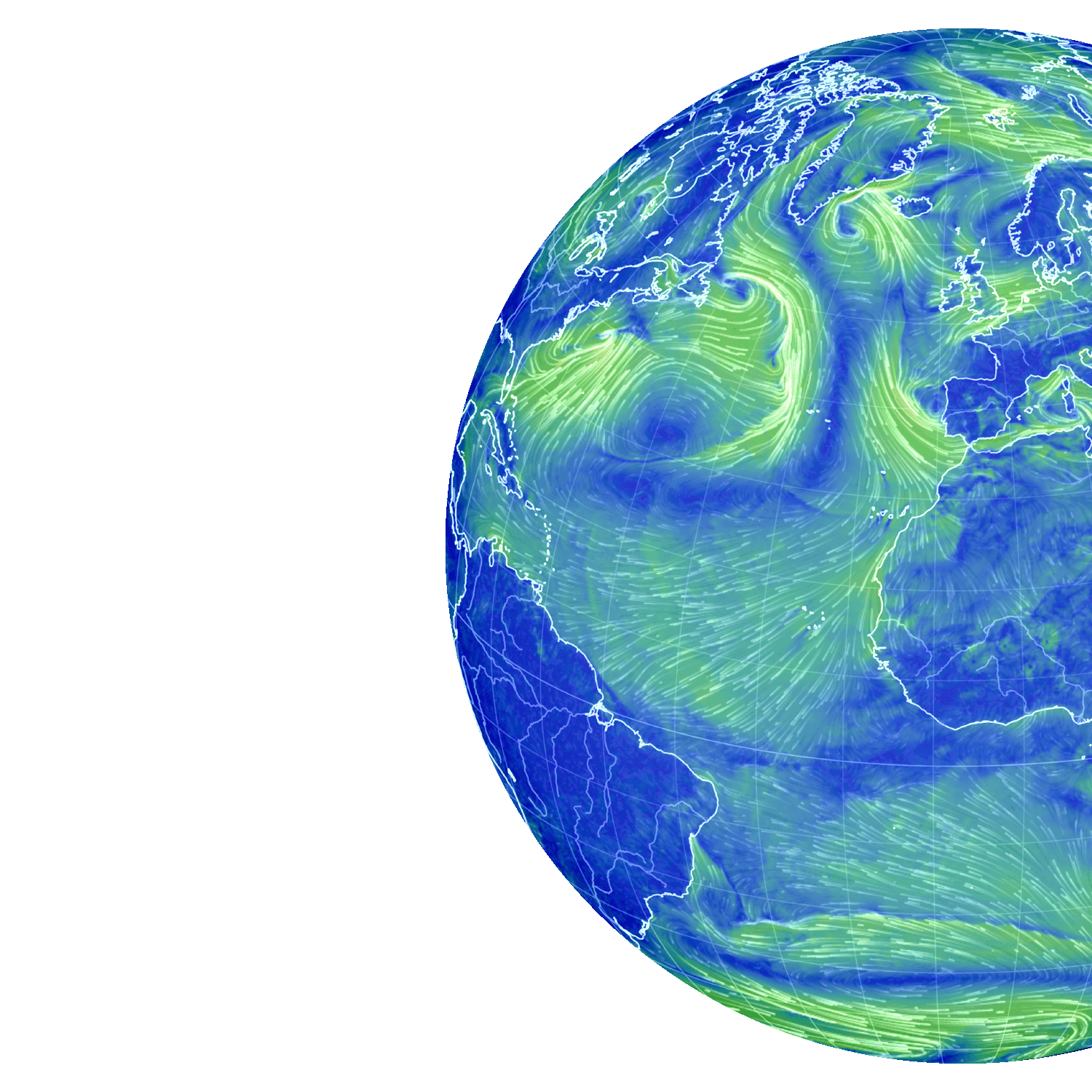Climate change involves not only a transformation of the Earth’s mantle of air and warmth but also its fluid organism. Meinhard Simon reflects on the balancing of warmth in ocean currents and in human blood circulation and what our responsibility for bringing down the Earth’s fever might be.
The balance of heat in human beings is wonderfully regulated by our blood circulation, with the heart at its center, to maintain a constant body temperature. Respiration plays a part through the relationship of our lungs with the air, the absorption of oxygen, and the release of carbon dioxide. Out of all warm-blooded creatures, human beings have the most perfectly regulated and constant body temperature—a sign of the fact that we are bearers of an “I”. Even the slightest increase in temperature accelerates our blood circulation, quickens our heartbeat, and affects our breathing. Looking at the Earth, we notice a commonality. Throughout its evolution, from the Tertiary period on, and especially since the appearance of our first human ancestors, the Earth has shown an increasingly constant and very stable mean annual temperature. This is significantly different from all other planets and is a signature of the life processes of the biosphere as a whole, that is to say, the whole Earth-being. Up to 70% of an adult human body consists of water; that same percentage of the surface of our planet is covered by oceans. Water has special properties that balance and regulate heat, so having a large proportion of the watery element is the foundation for finely tuned temperature regulation.


Figure 1: Ocean currents in the Atlantic (left) and Pacific (right) Oceans.
Ocean currents perform a similar function for the Earth as blood circulation does for human beings. In conjunction with atmospheric processes, ocean currents disseminate heat and cold, and create temperature differentiations in the various geographical regions. Heat is distributed primarily by surface currents in the tropics and subtropics and reaches the Arctic Ocean via the Gulf Stream.1 The permanently warm and stratified tropical and subtropical oceans are extremely poor in nutrients and support very few living organisms, particularly microbial life. They are like the deserts of the ocean.
Cold acts as a counterbalance, coming mainly from the Southern [Antarctic] Ocean, which is particularly receptive to the surrounding cosmos, and flowing to all the Earth’s oceans via the deep sea currents. The cold rises to the surface again in certain “upwelling regions” along the west coasts of the major continents, for example, in the Humboldt Current off South America and in the Benguela Current off southwestern Africa.2 Around three-quarters of the deep sea below 800 meters contains cold seawater originating in the Southern Ocean, an astonishing and little-known fact about this climatic region that underscores its importance for the world’s oceans and the entire biosphere. Rich in nutrients and high in oxygen, the cold waters of the Southern Ocean nourish and revitalize all the Earth’s oceans, allowing these upwelling regions to thrive with life and a great abundance of fish, birds, and marine mammals.
So, we have warm, nutrient-poor ocean areas in the tropics and subtropics contrasting with cold, nutrient-rich ocean areas in the deep sea, upwelling regions, and polar regions. The original source of warmth is, of course, the sun—the actual warmth center of the Earth (with a certain spatial distance)—just like the heart in human beings. In contrast to the warming sun, we have the polar regions of the Earth, through which the planet is cooled by the surrounding cosmos, especially in the southern Antarctic region.
The Relationship Between Winds in the Earth’s Atmosphere and Currents in the Oceans
The global winds and wind belts in both hemispheres, such as the westerlies and trade winds, are the primary force that transmits heat from the Earth’s atmosphere to the oceans and surface currents. We have all experienced how wind can blow quite differently, from barely perceptible breezes to overpowering, destructive hurricanes and tropical cyclones. The average global wind speeds over the oceans are actually rather moderate, 22 km/h (14 mph), wind force 4, about the speed of a brisk bike ride. The ocean currents flow at about the speed of a slow to fast human gait, 2–7 km/h (0.5–4.25 mph). The speed of the ocean currents is due to the force of the wind pushing the ocean waters (called wind forcing) and other factors such as the Coriolis effect and the high density of the very cold seawater at the poles.[1] The Gulf Stream, the Benguela Current, the Antarctic Circumpolar Current, and the North Equatorial Countercurrent in the Pacific are rather fast in comparison to the average. The speeds of the winds and the ocean currents are therefore in a 4:1 ratio.3 This is the same ratio as heartbeat to breath in human beings but reversed—fluid to air.


Figure 2: Winds (top) and ocean currents (bottom) in the Atlantic Ocean on April 20, 2020. Wind intensity is indicated by arrows and boxes and wind speed by a color spectrum from green (slow) to orange (fast). Source: EarthWindMap
The Impact of Global Warming on Winds and Ocean Currents
A group of physical oceanographers recently conducted a comprehensive analysis with model calculations using the available data from the past six decades on all the world’s oceans. To their surprise, they discovered that due to atmospheric and oceanic warming, the speeds of the ocean currents everywhere had increased during the period from 1990–2020, as compared with the same span of time from 1960–1990.4 The greatest increase was found in ocean currents in tropical and subtropical regions, with effects far into polar regions and down to ocean depths of 3,000 meters. Decreased velocities were found almost exclusively in cold currents, such as the Labrador Current in the North Atlantic, the Oyashio Current in the North Pacific, and the Antarctic Circumpolar Current in the northern region of the Southern Ocean. Evidently, the slowing down of cold currents was due to the accelerations of warm currents. An increase in wind speeds was identified as the cause of the increased ocean current velocities—wind speeds have increased an average of about 2 percent per decade compared to the same period in the past. It’s a seemingly small increase but with far-reaching effects and consequences. For one, the amount of energy introduced into the oceans by the winds more than doubled between 1990 and 2011 compared to the same time span from 1959 to 1989.
Many studies have documented the warming of the world’s oceans caused by the increase in global temperatures, which are in turn due to the increase in atmospheric greenhouse gases, such as carbon dioxide, methane, and nitrogenous nitrous oxide (N2O), that are released by human activities. This connection is no longer doubted by any serious researcher.5 The above-mentioned study shows that global warming is also accelerating the circulation of the world’s oceans, with a direct effect particularly on the warm ocean currents. This relationship is mirrored in human beings: increased temperature results in accelerated blood circulation.
As this acceleration of ocean currents continues and warm areas spread across more regions, fewer nutrients will be distributed, and there will be a decrease in fertile, nutrient-rich, cold upwelling areas. There are many other and more far-reaching consequences—the overall significance for the biosphere and human beings is still quite difficult to assess. The discovery of the acceleration of ocean currents gives us another clear indication of global warming and the resulting danger and threat to the health of the entire biosphere.
What Can We Do to Support the Health of Our Feverish Earth?
When a person or a doctor notices an increase in body temperature, usually in connection with other symptoms, they seek to discover the causes. To prevent even worse consequences to the person’s health, they ensure that the temporary increase will decrease again through health-restoring behaviors and therapies. In cases of identifiable diseases, a specific therapy will usually lead to a successful recovery, but restoring health is always a matter of stimulating and strengthening the organism’s self-healing powers, which is what homeopathic and anthroposophic remedies are specifically designed to do. However, the doctor and patient must also observe the body and important metabolic processes much more closely than usual and enter into an “I–Thou” relationship with the physical body and life body in order to follow the changing state of health closely throughout the healing process. For doctors to help bring about healing, this means developing—through a trained, exact imagination—a comprehensive picture of the patient, as is done in the methods first developed by Rudolf Steiner and Ita Wegman.67 In the case of an acute threat to health, for example, an infection, radical protective measures may be necessary, which will then need to be accepted. We all experienced this quite dramatically during the coronavirus crisis, when preventive and protective measures were accepted that not only affected individuals, but intervened massively in the everyday lives of people on a worldwide scale and restricted daily life in a way most human beings had never before experienced.
Today, the Earth is in a state of fever due to the human-caused warming of the climate. Beginning around 1850, at the start of the industrial age, the release of energy from the combustion of coal, oil, and natural gas resulted in increased global warming.[5] This was further exacerbated by all the resulting consequences of this warming for the life processes of the biosphere, as well as the existential effects on the life of human beings and societies across all the regions of the Earth.
In the early ages of the Earth, over millions of years, energy from the sun was bound in the carbon of ancient vegetation, especially in the Paleozoic era, and eventually became our fossil fuels of today. However, these fuels are not just carriers of physical energy: the solar energy bound by the Earth was an essential contribution to the Earth-being’s ability to develop temperature homeostasis. This, in turn, supported the evolutionary processes that led to the appearance of human beings.
When we consider that, today, as much energy is released worldwide per year as was bound by the Earth over a span of one million years, we can see how modern, mechanized human civilization is rapidly undoing what was created over vast periods of time by the Earth-being, together with the sun, as a prerequisite for the present life of humanity. The energy released from fossil fuels mainly serves the further development and design of the technologized world and makes the lives of many people much more pleasant and comfortable. However, this is at the expense of the natural environment and, perhaps worse, at the expense of our social environment. Human awareness and attitudes concerning this use of energy are still mainly determined by the intellectual or mind soul and only slightly by the consciousness soul, that part of our soul which actually corresponds with the present time of Earth and human development.
The Responsibility Will Not Pass from Our Hands
Changes on the Earth that were brought about by global warming are occurring at an unprecedented rate in the overall evolution of Earth, but only slowly for human perception.[5] That being said, it is no longer possible to ignore these changes. We have all now experienced or witnessed the unusually warm summers and long periods of drought in many countries, the warming of the oceans and all its consequences, the glacial retreat in mountains, and the thawing of the permafrost. Usually, we only perceive these changes with our intellect. Nearly all the proposals and measures to reduce greenhouse gas emissions—which are usually quite sensible—arise out of this intellectual mindset. When such proposals become more radical—such as rapidly ending the use of coal, switching to renewable energy sources, or eliminating air travel—there is an outcry around the world, apparently because this threatens our comfortable, familiar, and pleasantly sufficient lifestyle and economy to such an extent that there is a great fear of massive societal and economic meltdown.
In order for us to take responsibility for the environment, must conditions be as dramatic as they were during the coronavirus crisis? For a relatively short time, across the globe, people accepted severe restrictions on everyday life, although, importantly, they had the prospect of an eventual end in the not-too-distant future. Corresponding measures against global warming would not be possible in such a short period of time; global processes of change occur over very long periods.
The intense, immediate concern we experience in an “I–Thou” relationship with a person or a being close to us, which was so apparent during the coronavirus situation, is obviously not present in relation to our surrounding world and the threat of global warming, or, only in a rudimentary form and in too few individuals. The development of the “I–Thou” relationship with the world around us, nature, and all the life processes of the Earth requires that we bring their essence, their being-ness, into our consciousness and incorporate this consciousness into our activities. This is how we act responsibly out of knowledge and love for the Earth-being, and it corresponds to the perspective and awareness of the consciousness soul. Obviously, this is still very difficult for us in a larger context that will have a positive effect on the climate. But, it can be an important foundation for a sustainable therapy to reduce the overheating of the Earth and thereby decelerate the winds and the surface ocean currents. Many young people today seem to have a healthy sense of this “I–Thou” relationship with the Earth and are much less entrenched in the old intellectual and mind soul perspectives. A new relationship with the Earth seems to be emerging in them, one that grows much more directly out of the consciousness soul.
Rudolf Steiner showed, in a variety of ways, how we can develop such an “I–Thou” relationship with nature and the Earth as a whole. But, he also showed how we can develop such an attitude in social contexts and how we must do so as modern human beings if we really want to fulfill our responsibility for the development of the Earth’s beings.89 This is of great importance for the further development of nature and the Earth because only in this way can these beings that are always active in nature become active in a healthy way and fully support our actions for a further evolution attuned to the climate.
Rudolf Steiner also indicated ways in which we can take healthy actions for the Earth. The preparations used in biodynamic agriculture activate spiritual forces that improve the quality of agricultural products, for example.10 But the use of biodynamic preparations has also been proven to improve soil quality and reduce the release of nitrogenous greenhouse gases.11 So, by promoting and supporting biodynamic agriculture, every human being contributes to strengthening the Earth’s self-healing from global warming, with the farmers assuming the role of specially-trained therapists. Such a seemingly small contribution can actually be of great significance. But it should not prevent us from contributing in our own way, wherever and however possible, to curbing the warming of the climate that we ourselves have caused and continue to cause. The further development of the climate and the Earth, and all that is connected with this development, depends more and more on whether we, as human beings, actually take responsibility for this evolutionary process. The responsibility will not pass from our hands.
Title image Where there is water, air moves it; where there is land, water slows down. Solar heat is a play of the elements. Pictured here: air movements over the Atlantic Ocean on April 20, 2020 from an altitude of approx. 100 meters. Source: EarthWindMap
Footnotes
- S. Kümmell, “Immerwährende Bewegung: Meeresströmungen zwischen Sonne und Erde” [Perpetual Motion: Ocean currents between Sun and Earth], Jahrbuch für Goetheanismus [Yearbook for Goetheanism] (2011): 151–184.
- M. Simon, “Die Antarktis: Eine unbekannte Klimaregion im Organismus der Erde” [The Antarctic: An unknown Region of the Climate in the Earth Organism], Die Drei, no. 11 (Nov. 2007): 41–54.
- Up-to-date information on winds and ocean currents is easily available on the Internet at EarthWindMap.
- S. Hu et al., “Deep-Reaching Acceleration of Global Mean Ocean Circulation Over the Past Two Decades,” Science Advances 6, no. 6 (Feb. 5, 2020): eaax7727.
- H.-U. Schmutz, “Vom Klimawandel zum Klimabruch” [From Climate Change to Climate Breakdown], Das Goetheanum 36, (Sept. 5, 2019): 6–9.
- Rudolf Steiner and Ita Wegman, Extending Practical Medicine: Fundamental Principles Based on the Science of the Spirit, CW 27, translated from the German by Anna R. Meuss (Rudolf Steiner Press, 1997).
- Rudolf Steiner, Introducing Anthroposophical Medicine, CW 312, translated from the German by Catherine E. Creeger (SteinerBooks, 2010).
- Rudolf Steiner, The Influences of Lucifer and Ahriman: Human Responsibility for the Earth, CW 191, translated from the German by D. S. Osmond (SteinerBooks, 1976), lecture in Dornach on Nov. 9, 1919.
- Rudolf Steiner, Awake! For the Sake of the Future, CW 220, translated from the German by Jann W. Gates (SteinerBooks, 2014), lecture in Dornach on Jan. 20, 1923.
- Rudolf Steiner, Agriculture Course: The Birth of the Biodynamic Method, CW 327, translated from the German by George Adams (Rudolf Steiner Press, 2004).
- C. Skinner et al. “The Impact of Long-term Organic Farming on Soil-derived Greenhouse Gas Emissions.” Scientific Reports 9, 1702 (2019).






She, who has the whole in His Hands, is not a mechanical system. Numbers cannot capture the Being of the Holy Mother – Earth Mother. She is the Rider of the Four Horseman (conquest, plague, famine, and death). She speaks through the Weather. and at the moment of the heating up of the war in the Middle East, She transformed a Category One storm into a Category Five, in twelve hours.
The aristotelians in the Society need to meet with the platonists, i.e. those who practice and are initiated into the new Feminine Mysteries.
https://thecollectiveimagination.com/details-on-the-mysteries-of-the-mother/
MOTHER EARTH 🌍
The earth is our mother,
we will not have another.
There’s no better place to find
for animals, plants, mankind.
Green woods, beautiful lakes,
nature has got, what it takes.
We have to keep clean the air,
as environment everywhere.
Put an end to coal mining,
nuclear power and fracking.
Climate concerns all nations,
just as plastic in the oceans.
For good living day and night
must change darkness and light.
Our planet, so wonderful blue,
we always will protect, we do!
Rainer Kirmse , Altenburg
With kind regards
Herzliche Grüße aus Thüringen